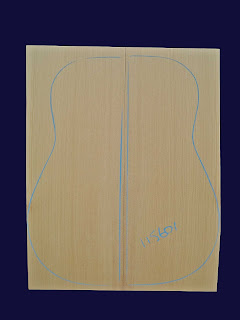Hopefully, this post marks a transition to business as usual after the disruptive and sometimes stressful process of moving house. As if that wasn't enough of a distraction, our newly acquired house and garden required a time-consuming facelift, but with much of that work now behind us, I can at last devote some guilt-free time to my hobbies.
To ease myself back into normality, I've spent a little time working on the headstocks of the two guitars I'm currently building. Using a masonite template as a guide, I've band-sawn the headstocks to within a couple of millimetres of their final shape then accurately affixed the template to the headstock face using the indispensable and ever-present double-sided tape; a few taps from a soft-faced hammer ensures that the template is firmly attached to the headstock's face. The laminate trimmer I use to complete this job is adjusted so that a bearing on the shaft of the router bit rides along the edges of the template. Using this arrangement, it's then a relatively straightforward task to reduce the headstock to its final shape.
 |
| Macassar ebony headplate |
I've learned the hard way that when using this method consideration needs to be given to grain direction and the trimmer's direction of travel if damage to the headstock is to be avoided. Trimming the extremities of the headstock's end where they transition into its long edges demands special attention. On the upper corner of the headstock corresponding to the bass side of the neck, I guide the trimmer in a clockwise direction, effectively "climb-cutting" as the bit begins trimming the headstock's end adjacent to that corner; on the opposite upper corner of the headstock corresponding to the treble side of the neck, I guide the trimmer in an anti-clockwise direction. As an added precaution, I trim the end of the headstock before I trim its sides so that any minor chipping will be removed when the long edges are trimmed as a final step. Needless to say, different headstock shapes will require their own unique approach.
Observing the same precautions described above, I've also routed out the ledge that accommodates the headstocks' purflings and bindings, this time using a spiral-downcut router bit and the trimmer's adjustable guide. The rebate on one of the headstocks is pictured below, with the final result on the other shown for comparison. Hopefully, I'll have both of the headstocks completed before the weekend is over.
 |
| Laminate trimmer, with bearing guide fitted |
 |
| Binding rebate prepared |
 |
| Bound and ready for clean-up |
I mentioned in my previous post that my plan was to construct a purpose-built workshop at the rear of the house. It's still an attractive proposition, but after much thought, I decided that at this point in time I'm unwilling to sacrifice what could easily be another twelve months of my life to such a major project - spare time is in short supply as it is. Another significant factor in my shelving of those plans is that once we'd found homes for the assortment of bits and pieces we all seem compelled to accumulate, a generous amount of usable space remained in the double garage at the front of the house. Importantly, with an abundance of fluorescent ceiling lights in the garage, lighting is more than adequate for my purposes. If there's a downside to my use of the garage for guitar building, it's that my partner may find her car coated in wood dust from time to time - I'm sure she'll understand!
Cheers
Pete




















